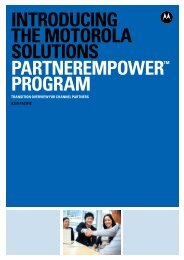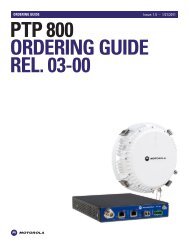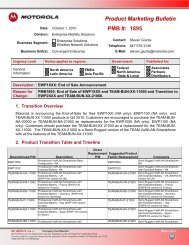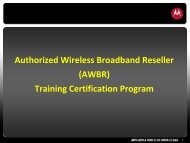<strong>PMP</strong> <strong>400</strong> and PTP 200 Series<strong>Canopy</strong> <strong>User</strong> <strong>Guide</strong> <strong>Supplement</strong>2.3 CONFIGURATION OPTIONS – RF, IP, DFSThese systems use <strong>the</strong> <strong>Canopy</strong> Media Access Controller (MAC) layer. Settings like DownlinkData %, Range, and Control Slots are similar <strong>to</strong> <strong>Canopy</strong> FSK radios. An AP can communicate <strong>to</strong>over 200 SMs, similar <strong>to</strong> a <strong>Canopy</strong> FSK AP.The GUI (Graphical <strong>User</strong> Interface) is almost identical <strong>to</strong> <strong>Canopy</strong>’s, with a few additions <strong>to</strong>support OFDM-specific features.Network features like High Priority using DiffServ, MIR, CIR, NAT, DHCP and VLAN are availablefor <strong>the</strong> <strong>PMP</strong> <strong>400</strong> and PTP 200 Series OFDM radios, and are configured in <strong>the</strong> same way as <strong>the</strong>yare for <strong>the</strong> <strong>PMP</strong> 100 and 200 Series and PTP 100 Series radios.In <strong>the</strong> 5.4 GHz band, DFS (Dynamic Frequency Selection) is provided for regula<strong>to</strong>ry complian<strong>to</strong>peration, and is activated using <strong>the</strong> “Region Code” feature. Two alternate frequencies can beconfigured <strong>to</strong> provide service in <strong>the</strong> unlikely case a module detects radar and triggers DFS, <strong>the</strong>same as standard <strong>Canopy</strong>. “External Antenna Gain” may need <strong>to</strong> be configured consistent withany antennas used, <strong>to</strong> avoid making <strong>the</strong> system overly sensitive <strong>to</strong> radar detection. “Whitening,” atechnique used <strong>to</strong> avoid self-interference on <strong>Canopy</strong> FSK radios is not offered as an option on <strong>the</strong><strong>PMP</strong> <strong>400</strong> and PTP 200 Series radios, as whitening is not a technology applicable <strong>to</strong> an OFDMsignal.2.4 RELEASE MAPPING TO PRODUCTS<strong>Release</strong>s run on <strong>the</strong> various products as follows:• <strong>Release</strong> 9.0 or <strong>Release</strong> 8.2.x runs on <strong>Canopy</strong> FSK radios (<strong>PMP</strong> 100 and 200 andPTP 100 Series radios).• <strong>Release</strong> 8.4.x runs on <strong>PMP</strong> 54<strong>400</strong> and PTP 54200 Series OFDM radios.• “<strong>Release</strong> 8.3” is not planned <strong>to</strong> be used for release numbering.• <strong>Release</strong> 9.3.1 runs on <strong>PMP</strong> 49<strong>400</strong> Series OFDM radios2.5 POWER AND GROUNDINGThe <strong>PMP</strong> <strong>400</strong> and PTP 200 Series radios use a 30 VDC nominal power system, instead of <strong>the</strong> 24VDC nominal power system used previously in standard <strong>Canopy</strong>. A new 30 VDC power supply isavailable for <strong>the</strong> CMMmicro, and a new 30 VDC nominal (specified and labeled as 29.5 VDC)power supply is available for <strong>the</strong> SM.The new 30 VDC power supplies can also be used for standard <strong>Canopy</strong>, and are replacing <strong>the</strong> 24VDC power supplies in <strong>the</strong> <strong>Canopy</strong> product line.The <strong>PMP</strong> <strong>400</strong> and PTP 200 Series radios have slightly higher power use than <strong>Canopy</strong> FSKradios, and <strong>the</strong> higher voltage is needed <strong>to</strong> carry <strong>the</strong> higher wattage on cable runs approaching<strong>the</strong> 100 meter (328 ft) maximum length. CMMmicro 24 VDC power supplies and <strong>the</strong> latest versionof SM 24 VDC power supplies can power <strong>PMP</strong> <strong>400</strong> and PTP 200 Series radios for shorter runs.Earlier versions of SM 24 VDC power supplies, especially <strong>the</strong> earlier heavier transformers,cannot. The best practice is <strong>to</strong> use 30 VDC power supplies with <strong>PMP</strong> <strong>400</strong> and PTP 200 Seriesradios, and avoid potential issues and cable-length-specific engineering.Due <strong>to</strong> <strong>the</strong> full metallic connection <strong>to</strong> <strong>the</strong> <strong>to</strong>wer or support structure through <strong>the</strong> AP’s antenna or aconnec<strong>to</strong>rized BH’s antenna, grounding of <strong>the</strong> AP or BH and a 600SSC surge suppressor within 3ft (1 m) of <strong>the</strong> AP or BH is strongly recommended <strong>to</strong> suppress overvoltages and overcurrents,such as those caused by near-miss lightning. APs and BHs provide a grounding lug for grounding<strong>to</strong> <strong>the</strong> <strong>to</strong>wer or support structure. A pole mount kit is available for <strong>the</strong> 600SSC, and provides agrounding lug that can be used for terminating grounding straps from both <strong>the</strong> 600SSC and <strong>the</strong>AP.Issue 3, January 2009 Page 10 of 45
<strong>PMP</strong> <strong>400</strong> and PTP 200 Series<strong>Canopy</strong> <strong>User</strong> <strong>Guide</strong> <strong>Supplement</strong>2.6 ADMINISTRATION SYSTEMSStandard <strong>Canopy</strong> administration systems are used <strong>to</strong> support <strong>the</strong> <strong>PMP</strong> <strong>400</strong> and PTP 200 Seriesproducts, with <strong>the</strong> only requirement being that <strong>the</strong> administration systems must be at <strong>the</strong>appropriate release level:• Prizm 3.1 is <strong>the</strong> element management system for <strong>PMP</strong> <strong>400</strong> and PTP 200 Seriesproducts. In addition <strong>to</strong> managing and moni<strong>to</strong>ring <strong>Canopy</strong> modules, Prizm 3.1 can beused <strong>to</strong> update <strong>the</strong>m.• CNUT 3.1 (<strong>Canopy</strong> Network Update Tool) is <strong>the</strong> stand-alone update <strong>to</strong>ol for <strong>PMP</strong> <strong>400</strong>and PTP 200 Series products for opera<strong>to</strong>rs not using Prizm.2.7 TECHNICAL DETAILS, SPECIFICATIONS, PERFORMANCE<strong>PMP</strong> <strong>400</strong> and PTP 200 systems consist of radios and antennas available in variouscombinations. The following sections list technical details for <strong>the</strong> radio and for each form fac<strong>to</strong>r.2.7.1 Radio specifications (common <strong>to</strong> all form fac<strong>to</strong>rs)• APs and BHs have settable Transmit Output Power.• SMs have Au<strong>to</strong> TPC (Transmit Power Control), set by <strong>the</strong> AP <strong>to</strong> provide powerleveling for close-in SMs• 5.4 GHz radios have a range of -30 <strong>to</strong> 10 dBm, and a default of 10 dBm.• 4.9 GHz radios have a range of -30 <strong>to</strong> 18 dBm, and a default of 18 dBm.• 12.5 W DC power2.7.2 Radio with integrated antenna – form fac<strong>to</strong>r specifications• Radio with an integrated, internal antenna• 18° x 18° 3 dB beam• 17 dBi gain for antenna at 5.4 GHz. 17 dBi antenna gain plus 10 dBm transmit powergives <strong>the</strong> regula<strong>to</strong>ry maximum 27 dBm EIRP.• 16 dBi gain for antenna at 4.9 GHz. 16 dBi antenna gain plus 18 dBm transmit powergives 34 dBm EIRP.• 2.8 lb, 13.25 x 8.25 x 3.75 in (hwd) (~1.3 kg, 34 x 21 x 9.5 cm)2.7.3 Connec<strong>to</strong>rized radio – form fac<strong>to</strong>r specifications• Connec<strong>to</strong>rized radio only (antenna <strong>to</strong> be provided by opera<strong>to</strong>r) – N-type connec<strong>to</strong>r• 2.8 lb, 13.25 x 8.25 x 3.75 in (hwd) (~1.3 kg, 34 x 21 x 9.5 cm)2.7.4 Kitted connec<strong>to</strong>rized radio specifications (antenna included) – form fac<strong>to</strong>rspecifications• Connec<strong>to</strong>rized radio and connec<strong>to</strong>rized antenna kitted <strong>to</strong>ge<strong>the</strong>r – N-type connec<strong>to</strong>r• 90° sec<strong>to</strong>rs• Antenna optimized for system coverage vs system self-interference for 90° sec<strong>to</strong>rs (3dB beam pattern of 60° azimuth by 5° elevation, with near-in null fill)• 18 dBi gain for antenna at 5.4 GHz. 18 dBi antenna gain minus 1 dB cable loss plus10 dBm transmit power gives <strong>the</strong> regula<strong>to</strong>ry max 27 dBm EIRP.• 17 dBi gain for antenna at 4.9 GHz. 17 dBi antenna gain minus 1 dB cable loss plus18 dBm transmit power gives 34 dBm EIRP.• 13 lb, 28 x 8.25 x 11 in (hwd) (~6 kg, 71 x 21 x 28 cm)Issue 3, January 2009 Page 11 of 45
















